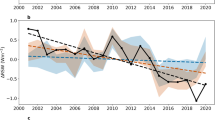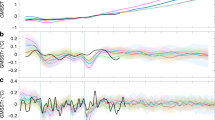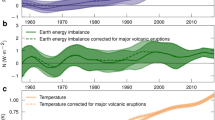Abstract
Our planet’s energy balance is sensitive to spatial inhomogeneities in sea surface temperature and sea ice changes, but this is typically ignored in climate projections. Here, we show the energy budget during recent decades can be closed by combining changes in effective radiative forcing, linear radiative damping and this pattern effect. The pattern effect is of comparable magnitude but opposite sign to Earth’s net energy imbalance in the 2000s, indicating its importance when predicting the future climate on the basis of observations. After the pattern effect is accounted for, the best-estimate value of committed global warming at present-day forcing rises from 1.31 K (0.99–2.33 K, 5th–95th percentile) to over 2 K, and committed warming in 2100 with constant long-lived forcing increases from 1.32 K (0.94–2.03 K) to over 1.5 K, although the magnitude is sensitive to sea surface temperature dataset. Further constraints on the pattern effect are needed to reduce climate projection uncertainty.
This is a preview of subscription content, access via your institution
Access options
Access Nature and 54 other Nature Portfolio journals
Get Nature+, our best-value online-access subscription
$29.99 / 30 days
cancel any time
Subscribe to this journal
Receive 12 print issues and online access
$209.00 per year
only $17.42 per issue
Buy this article
- Purchase on Springer Link
- Instant access to full article PDF
Prices may be subject to local taxes which are calculated during checkout




Similar content being viewed by others
Code availability
The code of CESM1.2-CAM5.3 model used in this paper can be downloaded from http://www.cesm.ucar.edu/models/cesm1.2/. Codes for plotting figures are available from the corresponding author upon request.
References
Trenberth, K. E., Fasullo, J. T., von Schuckmann, K. & Cheng, L. Insights into Earth’s energy imbalance from multiple sources. J. Clim. 29, 7495–7505 (2016).
Boucher, O. et al. in Climate Change 2013: The Physical Science Basis (eds Stocker, T. F. et al.) Ch. 7 (IPCC, Cambridge Univ. Press, 2013).
Stocker, T. F. et al. in Climate Change 2013: The Physical Science Basis (eds Stocker, T. F. et al.) 31–116 (IPCC, Cambridge Univ. Press, 2013).
Andrews, T., Gregory, J. M. & Webb, M. J. The dependence of radiative forcing and feedback on evolving patterns of surface temperature change in climate models. J. Clim. 28, 1630–1648 (2015).
Zhou, C., Zelinka, M. D. & Klein, S. A. Impact of decadal cloud variations on the Earth’s energy budget. Nat. Geosci. 9, 871–874 (2016).
Gregory, J. M. & Andrews, T. Variation in climate sensitivity and feedback parameters during the historical period. Geophys. Res. Lett. 43, 3911–3920 (2016).
Xie, S.-P., Kosaka, Y. & Okumura, Y. M. Distinct energy budgets for anthropogenic and natural changes during global warming hiatus. Nat. Geosci. 9, 29–33 (2016).
Zhou, C., Zelinka, M. D. & Klein, S. A. Analyzing the dependence of global cloud feedback on the spatial pattern of sea surface temperature change with a Green’s function approach. J. Adv. Model. Earth Syst. 9, 2174–2189 (2017).
Armour, K. C. Energy budget constraints on climate sensitivity in light of inconstant climate feedbacks. Nat. Clim. Change 7, 331–335 (2017).
Ceppi, P. & Gregory, J. M. Relationship of tropospheric stability to climate sensitivity and Earth’s observed radiation budget. Proc. Natl Acad. Sci. USA 114, 13126–13131 (2017).
Andrews, T. et al. Accounting for changing temperature patterns increases historical estimates of climate sensitivity. Geophys. Res. Lett. 45, 8490–8499 (2018).
Silvers, L. G., Paynter, D. & Zhao, M. The diversity of cloud responses to twentieth century sea surface temperatures. Geophys. Res. Lett. 45, 391–400 (2018).
Dessler, A. E., Mauritsen, T. & Stevens, B. The influence of internal variability on Earth’s energy balance framework and implications for estimating climate sensitivity. Atmos. Chem. Phys. 18, 5147–5155 (2018).
Dessler, A. E. Potential problems measuring climate sensitivity from the historical record. J. Clim. 33, 2237–2248 (2019).
Dong, Y., Proistosescu, C., Armour, K. C. & Battisti, D. S. Attributing historical and future evolution of radiative feedbacks to regional warming patterns using a Green’s function approach: the preeminence of the western Pacific. J. Clim. 32, 5471–5491 (2019).
Fueglistaler, S. Observational evidence for two modes of coupling between sea surface temperatures, tropospheric temperature profile, and shortwave cloud radiative effect in the tropics. Geophys. Res. Lett. 46, 9890–9898 (2019).
Leob, N. G. et al. New generation of climate models track recent unprecedented changes in earth’s radiation budget observed by CERES. Geophys. Res. Lett. 47, e2019GL086705 (2020).
Gregory, J. M. et al. A new method for diagnosing radiative forcing and climate sensitivity. Geophys. Res. Lett. 31, L03205 (2004).
Olonscheck, D., Rugenstein, M. & Marotzke, J. Broad consistency between observed and simulated trends in sea surface temperature patterns. Geophys. Res. Lett. 47, e2019GL086773 (2020).
Prather, M. G. et al. in Climate Change 2013: The Physical Science Basis (eds Stocker, T. F. et al.) 1395–1446 (IPCC, Cambridge Univ. Press, 2013).
Loeb, N. G. et al. Clouds and the Earth’s radiant energy system (CERES) energy balanced and filled (EBAF) top-of-atmosphere (TOA) edition-4.0 data product. J. Clim. 31, 895–918 (2018).
Allan, R. P. Decadal climate variability and the global energy balance. Past Glob. Changes 25, 20–24 (2017).
Andrews, T. & Forster, P. M. Energy budget constraints on historical radiative forcing. Nat. Clim. Change 10, 313–316 (2020).
Church, J. A. et al. Revisiting the Earth’s sea-level and energy budgets from 1961 to 2008. Geophys. Res. Lett. 38, L18601 (2011).
Levitus, S. et al. World ocean heat content and thermosteric sea level change (0–2000 m), 1955–2010. Geophys. Res. Lett. 39, L10603 (2012).
Mauritsen, T. & Pincus, R. Committed warming inferred from observations. Nat. Clim. Change 7, 652–655 (2017).
Forster, P. M. Inference of climate sensitivity from analysis of Earth’s energy budget. Annu. Rev. Earth Planet. Sci. 44, 85–106 (2016).
Sherwood, S. et al. An assessment of Earth’s climate sensitivity using multiple lines of evidence. Rev. Geophys. 58, e2019RG000678 (2020).
Smith, C. J. et al. Current fossil fuel infrastructure does not yet commit us to 1.5 °C warming. Nat. Commun. 10, 101 (2019).
Lewis, N. & Mauritsen, T. Negligible unforced historical pattern effect on climate feedback strength found in HadISST-based AMIP simulations. J. Clim. https://doi.org/10.1175/JCLI-D-19-0941.1 (2020).
Rayner, N. A. et al. Global analyses of sea surface temperature, sea ice, and night marine air temperature since the late nineteenth century. Geophys. Res. 108, 4407 (2003).
Hurrell, J. W., Hack, J. J., Shea, D., Caron, J. M. & Rosinski, J. A new sea surface temperature and sea ice boundary dataset for the Community Atmosphere Model. J. Clim. 21, 5145–5153 (2008).
Neale, R. B. et al. Description of the NCAR community atmosphere model (CAM 5.0) NCAR/TN-486+STR (National Centre for Atmospheric Research, 2012).
Meinshausen, M., Raper, S. C. B. & Wigley, T. M. L. Emulating coupled atmosphere-ocean and carbon cycle models with a simpler model, MAGICC6 – Part 1: model description and calibration. Atmos. Chem. Phys. 11, 1417–1456 (2011).
Rockström, J. et al. A roadmap for rapid decarbonization. Science 355, 1269–1271 (2017).
Flato, G. et al. in Climate Change 2013: The Physical Science Basis (eds Stocker, T. F. et al.) Ch. 9 (IPCC, Cambridge Univ. Press, 2013).
Etminan, M., Myhre, G., Highwood, E. J. & Shine, K. P. Radiative forcing of carbon dioxide, methane, and nitrous oxide: a significant revision of the methane radiative forcing. Geophys. Res. Lett. 43, 12614–12623 (2016).
Ciais, P. et al. in Climate Change 2013: The Physical Science Basis (eds Stocker, T. F. et al.) Ch. 6 (IPCC, Cambridge Univ. Press, 2013).
Zhou, T. & Chen, X. Uncertainty in the 2°C warming threshold related to climate sensitivity and climate feedback. J. Meteorol. Res. 29, 884–895 (2015).
Andrews, T., Gregory, J. M., Webb, M. J. & Taylor, K. E. Forcing, feedbacks and climate sensitivity in CMIP5 coupled atmosphere–ocean climate models. Geophys. Res. Lett. 39, L09712 (2012).
Eyring, V. et al. Overview of the coupled model intercomparison project phase 6 (CMIP6) experimental design and organization. Geosci. Model Dev. 9, 1937–1958 (2016).
Loeb, N. G. et al. Observed changes in top-of-the-atmosphere radiation and upper-ocean heating consistent within uncertainty. Nat. Geosci. 5, 110–113 (2012).
Wielicki, B. A. et al. Evidence for large decadal variability in the tropical mean radiative energy budget. Science 295, 841–844 (2002).
Otto, A. et al. Energy budget constraints on climate response. Nat. Geosci. 6, 415–416 (2013).
Jiménez-de-la-Cuesta, D. & Mauritsen, T. Emergent constraints on Earth’s transient and equilibrium response to doubled CO2 from post-1970s global warming. Nat. Geosci. 12, 902–905 (2019).
Acknowledgements
C.Z. was supported by NSFC grant no. 41875095. A.E.D. was supported by NSF grant nos. AGS-1661861 and AGS-1841308, both to Texas A&M University. M.D.Z. worked under the auspices of the US Department of Energy (DOE), Lawrence Livermore National Laboratory under contract no. DE-AC52-07NA27344 and was supported by the Regional and Global Model Analysis Program of the Office of Science at the DOE. M.W. was supported by Minister of Science and Technology of China grant nos. 2017YFA0604002 and 2016YFC0200503, and NSFC grant nos. 91744208, 41575073 and 41621005. This research is also supported by the Collaborative Innovation Center of Climate Change, Jiangsu Province. The numerical simulations in this paper were done on the computing facilities in the High Performance Computing Center of Nanjing University. Correspondence and requests for materials should be addressed to C.Z.
Author information
Authors and Affiliations
Contributions
C.Z. performed the analysis. The paper was discussed and written by all authors.
Corresponding author
Ethics declarations
Competing interests
The authors declare no competing interests.
Additional information
Peer review information Nature Climate Change thanks Jonah Bloch-Johnson, Diego Jiménez-de-la-Cuesta and the other, anonymous, reviewer(s) for their contribution to the peer review of this work.
Publisher’s note Springer Nature remains neutral with regard to jurisdictional claims in published maps and institutional affiliations.
Rights and permissions
About this article
Cite this article
Zhou, C., Zelinka, M.D., Dessler, A.E. et al. Greater committed warming after accounting for the pattern effect. Nat. Clim. Chang. 11, 132–136 (2021). https://doi.org/10.1038/s41558-020-00955-x
Received:
Accepted:
Published:
Issue Date:
DOI: https://doi.org/10.1038/s41558-020-00955-x
This article is cited by
-
Recent reductions in aerosol emissions have increased Earth’s energy imbalance
Communications Earth & Environment (2024)
-
Sea surface warming patterns drive hydrological sensitivity uncertainties
Nature Climate Change (2023)
-
Satellite-observed strong subtropical ocean warming as an early signature of global warming
Communications Earth & Environment (2023)
-
Objectively combining climate sensitivity evidence
Climate Dynamics (2023)
-
Estimating the timing of geophysical commitment to 1.5 and 2.0 °C of global warming
Nature Climate Change (2022)



